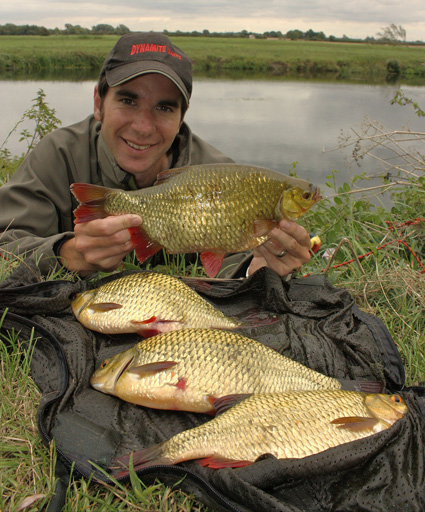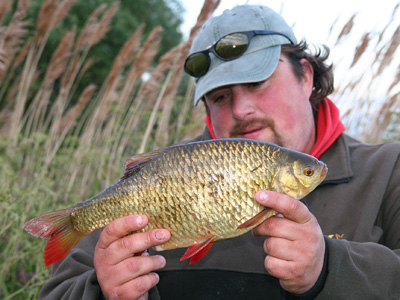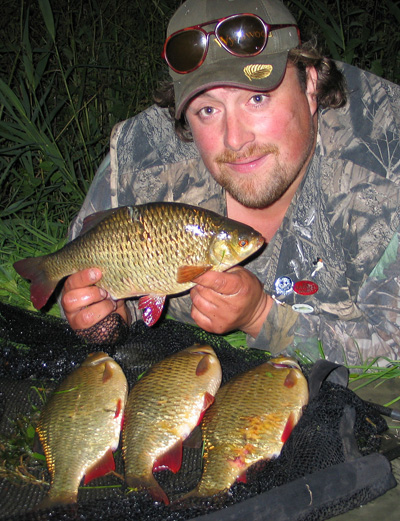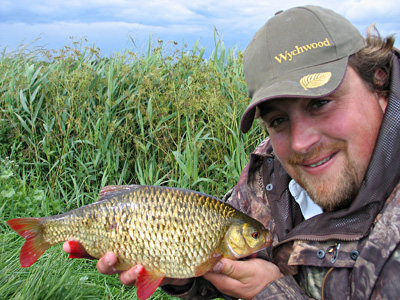Having started my angling writing career writing about predatory fish and predator fishing, in particular zander, many people are surprised when they ask me what my favourite fish is and I reply, “rudd”.
I am extremely lucky in that I live in a county that has always been one of the heartlands of big rudd in this country, Cambridgeshire, and with the upsurge of cormorants in the last couple of decades it is now one of the last bastions of big rudd in the country. The damage the ‘black death’ has done to rudd populations really cannot be overstated, even here. Some of the pits I fished as a boy that were full of rudd of all sizes are now practically devoid of the species. Here and there though they have survived and, in some cases, prospered; and these days, if you do your homework, there are still a number of places that could well produce the rudd of your dreams.
So, just what it is that makes the rudd so special?
 Well in my opinion there are no fish that are as good looking as the rudd! A big rudd is a stunning vision; going from a greenish-black back to golden flanks with those crimson red fins and deep orange eyes. There is also their rarity, which makes every big rudd you capture a hard-earned prize and on top of all that if you catch a big rudd on suitable gear they can pull back a bit too, what more could you ask for?
Well in my opinion there are no fish that are as good looking as the rudd! A big rudd is a stunning vision; going from a greenish-black back to golden flanks with those crimson red fins and deep orange eyes. There is also their rarity, which makes every big rudd you capture a hard-earned prize and on top of all that if you catch a big rudd on suitable gear they can pull back a bit too, what more could you ask for?
Catching big rudd though can be far from easy. Leaving aside the fact that they are not common, as a fish that feeds and spends a great deal of its time in the surface layers of the water they can be extremely skittish and a clumsy footfall or cast can see them melt away in an instant. However on another day when you have crept up on them and made the perfect cast they can be extremely co-operative, especially when spraying bait at them.
There is another side to rudd that is little written about and that’s the rudd’s nocturnal habits. Big rudd are very nocturnal creatures and tend to feed down at the bottom of the water instead of their usual upper water feeding. It’s at this time that the absolute biggest rudd can be targeted, especially if your water holds a lot of smaller fish that can frustrate you in the daytime with spray fishing tactics. My favourite tactic for night time fishing is to use mini boilies and groundbait feeders set up on a helicopter or inline lead rig scaled down from carp fishing. Bait is either mini boilies or 2 grains of real corn and one of fake as this makes the bait semi balanced, very important when rudd fishing as rudd physically cannot feed off the bottom; what they actually do is to either swim very fast past the food item or nudge it with their nose to get it to float up off the bottom, from where it is taken on the drop. Therefore a longish hooklength should also be employed along with a fine gauge hook.
 I tend to employ my night time feeder tactics over a bed of groundbait, hemp and corn and shy away from maggots completely; at night maggots tend to attract eels and in the daytime small rudd. Bread is also be a good bait, however, it is prone to getting hammered by small fish so personally I limit its use to stalking or float fishing where I can either see the bait or re-casting regularly. Of course crust is an all-time classic bait and that holds as true today as it ever did and there are few sights in angling more alluring than seeing a big rudd taking pieces of crust off the top, but of course that’s fairly unlikely at night!
I tend to employ my night time feeder tactics over a bed of groundbait, hemp and corn and shy away from maggots completely; at night maggots tend to attract eels and in the daytime small rudd. Bread is also be a good bait, however, it is prone to getting hammered by small fish so personally I limit its use to stalking or float fishing where I can either see the bait or re-casting regularly. Of course crust is an all-time classic bait and that holds as true today as it ever did and there are few sights in angling more alluring than seeing a big rudd taking pieces of crust off the top, but of course that’s fairly unlikely at night!
The one thing that becomes very evident once you start night fishing for big rudd is that the fish have a very set patrol route. That’s not to say that they follow the same route in the same direction every night because they don’t, but they will at least appear somewhere along that patrol route at some point in the night. On one pit that I used to fish you could chart the progress of the rudd around the lake as the carp anglers started to get the tell tale blips and bleeps as the rudd fed on their hemp and smaller boilies. Rudd, like big roach, often get caught on boilies intended for carp and I have seen them take boilies up to 18mm in size, though how exactly they were going to eat them is beyond me!
 For most anglers though the rudd is a fish of summer days and dawns, though personally I rate evening as the best part of the day. The fish are then very evident as they take advantage of the last of the day’s hatching insects and they tend to feel far less vulnerable to attack as most fish eating birds are by then on their way back to roost. My favourite way to catch them at this time of day is by float fishing, either on the surface with bits of crust or flake, or on the drop spraying bait; my favourite being sweetcorn.
For most anglers though the rudd is a fish of summer days and dawns, though personally I rate evening as the best part of the day. The fish are then very evident as they take advantage of the last of the day’s hatching insects and they tend to feel far less vulnerable to attack as most fish eating birds are by then on their way back to roost. My favourite way to catch them at this time of day is by float fishing, either on the surface with bits of crust or flake, or on the drop spraying bait; my favourite being sweetcorn.
To fish this way is simplicity itself. My tackle consists of a 15/17ft commercial carp, rod a Leeda Assassin to be precise. These rods are now out of production which is a real shame as for large fish on the float I have yet to find a rod to beat it. The odd one does still come up on the second hand market and it’s well worth keeping your eye out for one as they are usually about £30 and a real bargain.
I couple this with either a fixed spool or closed faced reel; I tend to use the closed faced when fishing on the rivers as it takes some beating for long trotting with the fixed spool reserved for stillwater work. Coupled with this is a Drennan number 1 pellet waggler. These are ideal floats as they are thick in the body and buoyant so they can be seen very easily at distance or in low light and they also carry a good shotting of about two SSG making them relatively easy to punch out into any Fenland wind that’s blowing.
Most of the shot I pack around the float with just a single BB at about half depth to act as a tell tale shot (If I am fishing crust this is moved under the float too). One little tip that I picked up regards waggler fishing is to leave a gap of around an inch or so between the two locking shot as this means that when you strike the float will lay in line with your mainline rather than at right angles to it.
The float is then set to around 3-4 feet in depth and cast towards where I expect, or can see ,mooching rudd. Try not to cast directly upon the rudd themselves as this will almost certainly spook them, but cast beyond and draw the float back into position.
 Should you hook a rudd it is of paramount importance to get it away from the rest of the shoal as quickly as possible without spooking them. The best way I have found to do this is to make sure that the rudd doesn’t splash upon the surface until its well away from its shoal mates. To ensure this doesn’t happen rather than strike upwards I strike to the side and keep the rod low to the water, applying constant side strain. Don’t underestimate the fighting abilities of rudd either. They may not be the biggest fish in our waters but they tend to fight dirty, heading for snags, particularly reed stems which they have a nasty habit of twisting you around. Let a rudd get into a reed bed and the chances are that it’s going to get rid of the hook…
Should you hook a rudd it is of paramount importance to get it away from the rest of the shoal as quickly as possible without spooking them. The best way I have found to do this is to make sure that the rudd doesn’t splash upon the surface until its well away from its shoal mates. To ensure this doesn’t happen rather than strike upwards I strike to the side and keep the rod low to the water, applying constant side strain. Don’t underestimate the fighting abilities of rudd either. They may not be the biggest fish in our waters but they tend to fight dirty, heading for snags, particularly reed stems which they have a nasty habit of twisting you around. Let a rudd get into a reed bed and the chances are that it’s going to get rid of the hook…
Rudd are never likely to be as popular as roach, carp or tench with most anglers but they are a really worthy species in my opinion and my “Summer ruddin’, had me a blast”!










